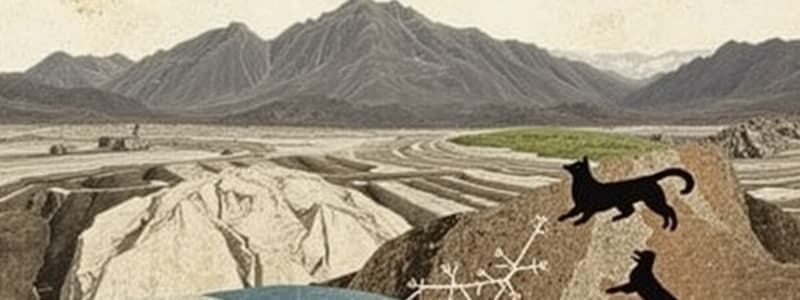Podcast
Questions and Answers
Which process is primarily responsible for the formation of moraines?
Which process is primarily responsible for the formation of moraines?
- Weathering by wind.
- Erosion by flowing water.
- Volcanic eruptions.
- Deposition of glacial sediments. (correct)
What geological feature commonly results from the convergence of tectonic plates?
What geological feature commonly results from the convergence of tectonic plates?
- Rift valleys.
- Mountain ranges. (correct)
- Shield volcanoes.
- Mid-ocean ridges.
In what type of climate is frost wedging most effective?
In what type of climate is frost wedging most effective?
- Hot and arid climates.
- Tropical rainforest climates.
- Climates with frequent freeze-thaw cycles. (correct)
- Warm and humid climates.
Which layer of the Earth is directly responsible for the movement of tectonic plates?
Which layer of the Earth is directly responsible for the movement of tectonic plates?
Which characteristic primarily distinguishes extrusive igneous rocks from intrusive igneous rocks?
Which characteristic primarily distinguishes extrusive igneous rocks from intrusive igneous rocks?
What type of rock is formed from the cooling and solidification of magma or lava?
What type of rock is formed from the cooling and solidification of magma or lava?
According to Wegener's theory of continental drift, what was the name of the supercontinent that existed millions of years ago?
According to Wegener's theory of continental drift, what was the name of the supercontinent that existed millions of years ago?
Which of the following provides evidence supporting the theory of continental drift?
Which of the following provides evidence supporting the theory of continental drift?
What is the primary composition of Earth's inner core?
What is the primary composition of Earth's inner core?
Which type of weathering involves the breakdown of rocks through chemical reactions?
Which type of weathering involves the breakdown of rocks through chemical reactions?
Flashcards
Erratic
Erratic
A large boulder that was transported by a glacier and deposited in an area with different bedrock.
Moraine
Moraine
A ridge-like accumulation of sediment formed by glacial deposition.
Converging Plates
Converging Plates
Tectonic plates moving towards each other, often resulting in subduction or mountain building.
Diverging Plates
Diverging Plates
Signup and view all the flashcards
Frost Wedging
Frost Wedging
Signup and view all the flashcards
Convection Currents
Convection Currents
Signup and view all the flashcards
Igneous Rock
Igneous Rock
Signup and view all the flashcards
Sedimentary Rock
Sedimentary Rock
Signup and view all the flashcards
Metamorphic Rock
Metamorphic Rock
Signup and view all the flashcards
Extrusive Igneous Rocks
Extrusive Igneous Rocks
Signup and view all the flashcards
Study Notes
- Erratic: A large rock or boulder that differs from the surrounding rock and was transported from a distant location by glacial ice.
- Moraine: A mass of rocks and sediment carried down and deposited by a glacier, typically as ridges at its edges or extremity.
- Converging Plates: Tectonic plates that move towards each other, resulting in collisions.
- Diverging Plates: Tectonic plates that move away from each other, resulting in new crust formation.
- Frost Wedging: A physical weathering process where water penetrates cracks in rocks, freezes and expands, causing the rock to fracture.
- Convection Currents: The transfer of heat through a fluid (liquid or gas) caused by differences in density.
Rock Families
- Igneous rocks form from the cooling and solidification of magma or lava.
- Sedimentary rocks form from the accumulation and cementation of sediments.
- Metamorphic rocks form when existing rocks are changed by heat, pressure, or chemical processes.
- Examples of each type: Granite (igneous), Sandstone (sedimentary), and Marble (metamorphic).
- Extrusive igneous rocks cool quickly on the Earth's surface, resulting in small crystals.
- Intrusive igneous rocks cool slowly beneath the Earth's surface, resulting in large crystals.
Wegener’s Theory of Continental Drift
- Alfred Wegener’s Theory of Continental Drift states that the continents were once joined together in a single landmass called Pangaea and have since drifted apart.
- Evidence #1: The continents fit together like puzzle pieces
- Example: The coastlines of South America and Africa match.
- Evidence #2: Fossil evidence
- Example: Similar fossils found on different continents.
- Evidence #3: Rock and mountain correlation
- Example: Similar rock formations and mountain ranges found on different continents
- Evidence #4: Paleoclimate data
- Example: Evidence of past glaciations in areas that are now tropical
Tectonic Plates
- Tectonic plates are pieces of Earth’s crust and uppermost mantle (lithosphere) that move and interact, causing earthquakes, volcanic activity, and mountain building.
Layers of the Earth
- Inner Core: Solid, made of iron and nickel, does not play a role in plate tectonics.
- Outer Core: Liquid, made of iron and nickel, does not play a role in plate tectonics.
- Mantle: Solid, made of silicate rocks, plays a role in plate tectonics due to convection currents.
- Asthenosphere: A highly viscous, mechanically weak and ductile region of the upper mantle, it lies below the lithosphere, at depths between approximately 80 and 200 km below the surface, the athenosphere plays a role in plate tectonics
- Lithosphere: Solid, made of the crust and upper part of the mantle, plays a direct role in plate tectonics.
Types of Weathering
- Physical Weathering: The disintegration of rocks without any chemical change.
- Example 1: Frost wedging, where water freezes and expands in cracks, breaking rocks apart.
- Example 2: Abrasion, where rocks collide and wear each other down.
- Chemical Weathering: the decomposition of rocks through chemical reactions.
- Example 1: Oxidation, where minerals react with oxygen, causing rust.
- Example 2: Acid rain, where pollutants dissolve rocks.
Studying That Suits You
Use AI to generate personalized quizzes and flashcards to suit your learning preferences.




